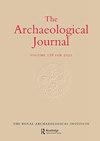An Early Iron Age palisaded enclosure in a multi-phase setting: excavations at Bleakmoor Hill
IF 0.8
0 ARCHAEOLOGY
引用次数: 0
Abstract
ABSTRACT The dating of palisaded enclosures in Britain remains poorly understood with few sites having been directly dated by scientific means using suitable, reliable samples. Excavations to support a possible planning application for an extension at Harden Quarry, Northumberland, provided the impetus to investigate a Scheduled palisaded enclosure on the edge of the Cheviot Hills, where one of the largest concentrations of these monument types is known. Excavation was also undertaken on adjacent features including a ring cairn, clearance cairn, and land allotment boundary. The palisaded enclosure contained a multiphase settlement within it, but the palisaded phase of the site appeared to be single phase and was securely radiocarbon dated to the late sixth – fifth century cal. BC. It is thought most likely that the linear boundary feature relates to a field system connected to the use of the palisaded settlement. Evidence for Mesolithic activity on the hilltop was attested by chipped flints and radiocarbon dates from a later feature. The clearance cairn likely dates to the Beaker period whilst cremations from the ring cairn were dated to the Early Bronze Age. Later cord rigg agriculture could be seen to overlie the ring cairn, palisaded enclosure and linear boundary.一个早期铁器时代的栅栏围栏在一个多阶段的设置:在布雷克穆尔山的挖掘
英国围栏的年代仍然知之甚少,很少有遗址通过科学手段使用合适的,可靠的样本直接确定年代。为支持在诺森伯兰郡哈登采石场可能的扩建规划申请而进行的挖掘工作,推动了对Cheviot山边缘的预定围栏的调查,那里是这些纪念碑类型已知的最大集中之一。邻近的石堆,包括环形石堆、清理石堆和土地分配边界也进行了挖掘。围篱的围墙内包含了一个多相的定居点,但该遗址的围篱阶段似乎是单相的,放射性碳测定的年代可以追溯到公元前6 - 5世纪晚期。人们认为,线性边界特征很可能与使用栅栏沉降有关的场系统有关。山顶上中石器时代活动的证据由燧石碎片和后来一个特征的放射性碳年代证明。清理石堆可能可以追溯到烧杯时期,而环形石堆的火化可以追溯到青铜时代早期。后来的索具农业可以看到覆盖在环形石堆,围栏和线性边界。
本文章由计算机程序翻译,如有差异,请以英文原文为准。
求助全文
约1分钟内获得全文
求助全文

 求助内容:
求助内容: 应助结果提醒方式:
应助结果提醒方式:


